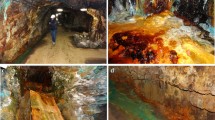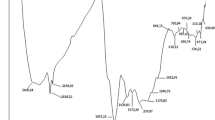Abstract
The potential of a Cu/Ni mining slag to act as a substrate for the growth of the bacteria Thiobacillus ferrooxidans, Thiobacillus thiooxidants, and Thiobacillus thioparus was examined. As well, slag and seepage samples were screened for the presence of the Thiobacillus species. For the 28 samples employed in the environmental recovery studies, T. ferrooxidans was recovered in 25 samples, T. thiooxidans in 19 samples, and T. thioparus in 27 samples. For T. ferrooxidans, the development of a colour change in the medium corresponded with the presence of motile bacilli as detected microscopically. For T. thiooxidans and T. thioparus, a decrease in culture pH of greater than 0.2 units usually corresponded with the presence of motile bacilli. The potential for growth on slag was determined by adding slag samples to media (devoid of an electron donor) appropriate for the growth of the three Thiobacillus species. All pulverized slag samples supported the growth of the three species.
Similar content being viewed by others
References
Duncan DW, Walden CC & Trussel PC (1966) Biological leaching of mill products. Can. Min. Metall. Bull. 59: 1075-1079
Frattini CJ, Ferroni GD & Leduc LG (1995) Studies on the reactivity of Cu-Ni slag. In: Lortie L, Gould WD & Rajan S (Eds) BIOMINET Proceedings, SP95-1 (pp 45-61). Mineral Resources Canada, Ottawa
Leduc LG & Ferroni GD (1994) The chemolithotrophic bacterium Thiobacillus ferrooxidans. FEMS Microbiol. Rev. 14: 103-120
Leduc LG, Trevors JT & Ferroni GD (1993) Thermal characterization of different isolates of Thiobacillus ferrooxidans. FEMS Microbiol. Lett. 108: 189-194
Lundgren DG & Silver M (1980) Ore leaching by bacteria. Ann. Rev. Microbiol. 34: 262-283
Manning HL (1975) New medium for isolating iron-oxidizing and heterotrophic acidophilic bacteria from acid mine drainage. Appl. Microbiol. 30: 1010-1016
Robbins DA, Bundy SD & Stanga GR (1983). Availability of toxic metals from non-ferrous metallurgical slags using various testing procedures. In: Sohn HY, George DB & Zunkel AD (Eds) Advances in sulfide smelting, The Metallurgical Society of AIME. 2: 923-934
Scales M (1986) Smelter modernization. Can. Min. J. 107: 44-50.
Tuovinen OH & Kelly DP (1973) Studies on the growth of Thiobacillus ferrooxidans I. Use of membrane filters and ferrous iron agar to determine viable numbers, and comparison with 14CO2-fixation and iron oxidation as measures of growth. Arch. Microbiol. 88: 285-298
Wilson LJ (1994) Literature review on slag leaching. Natural Resources Canada, CANMET Division Report MSL 94-3 (CR)
Author information
Authors and Affiliations
Rights and permissions
About this article
Cite this article
Male, D., Leduc, L. & Ferroni, G. The potential of mining slag as a substrate for microbial growth and the microbiological analysis of slag and slag seepage. Antonie Van Leeuwenhoek 71, 379–386 (1997). https://doi.org/10.1023/A:1000248429732
Issue Date:
DOI: https://doi.org/10.1023/A:1000248429732




